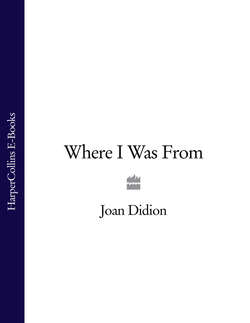Читать книгу Where I Was From - Joan Didion - Страница 7
2
Оглавление“ONE hundred years ago, our great-great-grandparents were pushing America’s frontier westward, to California.” So began the speech I wrote to deliver at my eighth-grade graduation from the Arden School, outside Sacramento. The subject was “Our California Heritage.” Developing a theme encouraged by my mother and grandfather, I continued, made rather more confident than I should have been by the fact that I was wearing a new dress, pale green organdy, and my mother’s crystal necklace:
They who came to California were not the self-satisfied, happy and content people, but the adventurous, the restless, and the daring. They were different even from those who settled in other western states. They didn’t come west for homes and security, but for adventure and money. They pushed in over the mountains and founded the biggest cities in the west. Up in the Mother Lode they mined gold by day and danced by night. San Francisco’s population multiplied almost twenty times, until 1906, when it burned to the ground, and was built up again nearly as quickly as it had burned. We had an irrigation problem, so we built the greatest dams the world has known. Now both desert and valley are producing food in enormous quantities. California has accomplished much in the past years. It would be easy for us to sit back and enjoy the results of the past. But we can’t do this. We can’t stop and become satisfied and content. We must live up to our heritage, go on to better and greater things for California.
That was June 1948.
The pale green of the organdy dress was a color that existed in the local landscape only for the few spring days when the rice first showed.
The crystal necklace was considered by my mother an effective way to counter the Valley heat.
Such was the blinkering effect of the local dreamtime that it would be some years before I recognized that certain aspects of “Our California Heritage” did not add up, starting with but by no means limited to the fact that I had delivered it to an audience of children and parents who had for the most part arrived in California during the 1930s, refugees from the Dust Bowl. It was after this realization that I began trying to find the “point” of California, to locate some message in its history. I picked up a book of revisionist studies on the subject, but abandoned it on discovering that I was myself quoted, twice. You will have perhaps realized by now (a good deal earlier than I myself realized) that this book represents an exploration into my own confusions about the place and the way in which I grew up, confusions as much about America as about California, misapprehensions and misunderstandings so much a part of who I became that I can still to this day confront them only obliquely.
